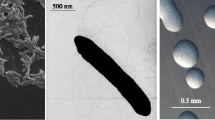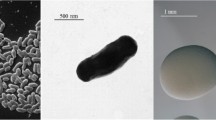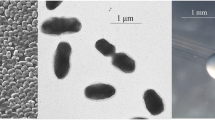Abstract
Rhizobium leguminosarum bv. trifolii strain WSM597 is an aerobic, motile, Gram-negative, non-spore-forming rod isolated from a root nodule of the annual clover Trifolium pallidum L. growing at Glencoe Research Station near Tacuarembó, Uruguay. This strain is generally ineffective for nitrogen (N2) fixation with clovers of Mediterranean, North American and African origin, but is effective on the South American perennial clover T. polymorphum Poir. Here we describe the features of R. leguminosarum bv. trifolii strain WSM597, together with genome sequence information and annotation. The 7,634,384 bp high-quality-draft genome is arranged in 2 scaffolds of 53 contigs, contains 7,394 protein-coding genes and 87 RNA-only encoding genes, and is one of 20 rhizobial genomes sequenced as part of the DOE Joint Genome Institute 2010 Community Sequencing Program.
Similar content being viewed by others
Introduction
A key factor which limits the productivity of agricultural systems is the availability of soil nitrogen (N). Legumes can overcome soil N limitations by forming symbiotic relationships with root nodule bacteria (rhizobia). Rhizobia, through their interaction with legumes, are able to reduce atmospheric dinitrogen (N2) into ammonia, which can supply essential N for growth to the plant. In addition, much of this fixed N is subsequently released into the soil following plant senescence and decay, grazing by livestock or human harvest [1], thereby increasing soil N content and fertility for subsequent crops. Thus, biological N2 fixation forms a vital component of sustainable agriculture as it provides a means of ameliorating N-deficient soils without the need for industrially synthesized N-based fertilizers, the production and application of which have significant environmental and economic costs [2].
Forage and fodder legumes play an integral role in sustainable farming practice, providing feed for stock while also enriching soil with available N. Worldwide, there are approximately 110 million ha of forage and fodder legumes under production [3], of which Trifolium spp. (clover) are of key importance [4]. The bacterial microsymbionts that nodulate clovers are Rhizobium leguminosarum bv. trifolii. Since Trifolium spp. are geographically widely distributed and are also phenologically variable (i.e. they may be either annual [e.g. T. subterraneum, T. pallidum and T. scutatum] or perennial [e.g. T. pratense, T. repens and T. polymorphum]), it is rare that a single strain of R. leguminosarum bv. trifolii can effectively fix N2 across a wide diversity of clovers [5].
Rhizobium leguminosarum bv. trifolii strain WSM597 was isolated from the nodules of Trifolium pallidum, which were collected from the INIA Glencoe Research Station, Uruguay in 1999. WSM597 is able to nodulate (Nod+) and fix (Fix+) N2 effectively on the South American perennial clover Trifolium polymorphum. However, while WSM597 is able to nodulate Trifolium pallidum and other annual and perennial Trifolium spp. of Mediterranean, African and North American origin, it is not effective for N2 fixation on any of these hosts (Yates et al., unpublished data). Therefore, WSM597 is highly specific for effectiveness in symbiosis, as is also evident with the recently sequenced South American clover microsymbiont R. leguminosarum bv. trifolii WSM2304 [6]. Thus, both microsymbionts demonstrate that phenological and geographic barriers exist for effective nodulation in clover symbioses. As this phenotype represents a common challenge to managing the legume-rhizobial symbiosis in agriculture, the genome of WSM597 is a valuable comparator for genetic studies of nodulation and N2 fixation. Here we present a summary classification and a set of general features for R. leguminosarum bv. trifolii strain WSM597 together with a description of the genome sequence and annotation.
Classification and general features
R. leguminosarum bv. trifolii strain WSM597 is a motile, Gram-negative rod (Figure Left and Center) in the order Rhizobiales of the class Alphaproteobacteria. It is fast growing in laboratory culture, forming colonies within 3–4 days when grown on half Lupin Agar (½LA) [7] at 28°C. Colonies on ½LA are white-opaque, slightly domed, moderately mucoid with smooth margins (Figure 1 Right). Minimum Information about the Genome Sequence (MIGS) is provided in Table 1. Figure 2 shows the phylogenetic neighborhood of R. leguminosarum bv. trifolii strain WSM597 in a 16S rRNA sequence based tree. This strain clusters closest to Rhizobium leguminosarum bv. trifolii T24 and Rhizobium leguminosarum bv. phaseoli RRE6 with 99.9% and 99.8% sequence identity, respectively.
Phylogenetic tree showing the relationships of Rhizobium leguminosarum bv. trifolii strain WSM597 (shown in blue print) with some of the root nodule bacteria in the order Rhizobiales based on aligned sequences of the 16S rRNA gene (1,307 bp internal region). All sites were informative and there were no gap-containing sites. Phylogenetic analyses were performed using MEGA, version 5.05 [23]. The tree was built using the maximum likelihood method with the General Time Reversible model. Bootstrap analysis [24] with 500 replicates was performed to assess the support of the clusters. Type strains are indicated with a superscript T. Strains with a genome sequencing project registered in GOLD [25] are in bold print and the GOLD ID is mentioned after the accession number. Published genomes are designated with an asterisk.
Symbiotaxonomy
R. leguminosarum bv. trifolii WSM597 nodulates (Nod+) and fixes N2 effectively (Fix+) with the South American perennial clover T. polymorphum. However, WSM597 is ineffective on perennial clovers of North American (T. reflexum and T. amabile) and African origin (T. sempilsoum). WSM597 is also ineffective on a range of Mediterranean annuals (T. resupinatum, T. clusii, T. michelianum, T. isthmocarpum, T. scutatum, T. incarnatum, T. tomentosum), including its host of origin T. pallidum and the North American annual T. bejariense (Yates, R., pers. comm.).
Genome sequencing and annotation information
Genome project history
This organism was selected for sequencing on the basis of its environmental and agricultural relevance to issues in global carbon cycling, alternative energy production, and biogeochemical importance, and is part of the Community Sequencing Program at the U.S. Department of Energy, Joint Genome Institute (JGI) for projects of relevance to agency missions. The genome project is deposited in the Genomes OnLine Database [25] and an improved-high-quality-draft genome sequence in IMG. Sequencing, finishing and annotation were performed by the JGI. A summary of the project information is shown in Table 2.
Growth conditions and DNA isolation
Rhizobium leguminosarum bv. trifolii strain WSM597 was grown to mid logarithmic phase in TY rich medium [26] on a gyratory shaker at 28°C. DNA was isolated from 60 mL of cells using a CTAB (Cetyl trimethyl ammonium bromide) bacterial genomic DNA isolation method [27].
Genome sequencing and assembly
The genome of Rhizobium leguminosarum bv. trifolii strain WSM597 was sequenced at the Joint Genome Institute (JGI) using a combination of Illumina [28] and 454 technologies [29]. An Illumina GAii shotgun library which generated 73,610,574 reads totaling 5,594.4 Mb, and a paired end 454 library with an average insert size of 14 Kb which generated 335,966 reads totaling 93.4 Mb of 454 data were generated for this genome. All general aspects of library construction and sequencing performed at the JGI can be found at the JGI website [30]. The initial draft assembly contained 190 contigs in 6 scaffolds. The 454 Titanium standard data and the 454 paired end data were assembled together with Newbler, version 2.3-PreRelease-6/30/2009. The Newbler consensus sequences were computationally shredded into 2 Kb overlapping fake reads (shreds). Illumina sequencing data were assembled with VELVET, version 1.0.13 [31], and the consensus sequences were computationally shredded into 1.5 Kb overlapping fake reads (shreds). The 454 Newbler consensus shreds, the Illumina VELVET consensus shreds and the read pairs in the 454 paired end library were integrated using parallel phrap, version SPS - 4.24 (High Performance Software, LLC). The software Consed (Ewing and Green 1998; Ewing et al. 1998; Gordon et al. 1998) was used in the following finishing process. Illumina data was used to correct potential base errors and increase consensus quality using the software Polisher developed at JGI (Alla Lapidus, unpublished). Possible mis-assemblies were corrected using gapResolution (Cliff Han, unpublished), Dupfinisher (Han, 2006), or sequencing cloned bridging PCR fragments with subcloning. Gaps between contigs were closed by editing in Consed, by PCR and by Bubble PCR (J-F Cheng, unpublished) primer walks. A total of 215 additional reactions were necessary to close gaps and to raise the quality of the finished sequence. The estimated genome size is 7.3 Mb and the final assembly is based on 57.2 Mb of 454 draft data which provides an average 7.8× coverage of the genome and 5,578.3 Mb of Illumina draft data which provides an average 764.2× coverage of the genome.
Genome annotation
Genes were identified using Prodigal [32] as part of the DOE-JGI Annotation pipeline [33], followed by a round of manual curation using the JGI GenePRIMP pipeline [34]. The predicted CDSs were translated and used to search the National Center for Biotechnology Information (NCBI) non-redundant database, UniProt, TIGRFam, Pfam, PRIAM, KEGG, COG, and InterPro databases. These data sources were combined to assert a product description for each predicted protein. Non-coding genes and miscellaneous features were predicted using tRNAscan-SE [35], RNAMMer [36], Rfam [37], TMHMM [38], and SignalP [39]. Additional gene prediction analyses and functional annotation were performed within the Integrated Microbial Genomes (IMG-ER) platform [40].
Genome properties
The genome is 7,634,384 nucleotides with 61.01% GC content (Table 3) in 2 scaffolds containing 53 contigs. From a total of 7,481 genes, 7,394 were protein encoding and 87 RNA only encoding genes. The majority of genes (79.24%) were assigned a putative function whilst the remaining genes were annotated as hypothetical. The distribution of genes into COGs functional categories is presented in Table 4 and Figure 3.
Graphical map of the two DNA scaffolds of Rhizobium leguminosarum bv. trifolii strain WSM597. From outside to the center: Genes on forward strand (color by COG categories as denoted by the IMG platform), Genes on reverse strand (color by COG categories), RNA genes (tRNAs green, sRNAs red, other RNAs black), GC content, GC skew.
References
Howieson JG, O’Hara GW, Carr SJ. Changing roles for legumes in Mediterranean agriculture: developments from an Australian perspective. Field Crops Res 2000; 65:107–122. http://dx.doi.org/10.1016/S0378-4290(99)00081-7
Good AG, Beatty PH. Fertilizing nature: a tragedy of excess in the commons. PLoS Biol 2011; 9:e1001124. PubMed http://dx.doi.org/10.1371/journal.pbio.1001124
Herridge DF, Peoples MB, Boddey RM. Global inputs of biological nitrogen fixation in agricultural systems. Plant Soil 2008; 311:1–18. http://dx.doi.org/10.1007/s11104-008-9668-3
Zohary M, Heller D. The Genus Trifolium. Jerusalem: The Israel Academy of Sciences and Humanities Ahva Printing Press; 1984.
Howieson J, Yates R, O’Hara G, Ryder M, Real D. The interactions of Rhizobium leguminosarum biovar trifolii in nodulation of annual and perennial Trifolium spp. from diverse centres of origin. Aust J Exp Agric 2005; 45:199–207. http://dx.doi.org/10.1071/EA03167
Reeve W, O’Hara G, Chain P, Ardley J, Brau L, Nandesena K, Tiwari R, Malfatti S, Kiss H, Lapidus A, et al. Complete genome sequence of Rhizobium leguminosarum bv. trifolii strain WSM2304, an effective microsymbiont of the South American clover Trifolium polymorphum. Stand Genomic Sci 2010; 2:66–76. PubMed http://dx.doi.org/10.4056/sigs.44642
Howieson JG, Ewing MA, D’antuono MF. Selection for acid tolerance in Rhizobium meliloti. Plant Soil 1988; 105:179–188. http://dx.doi.org/10.1007/BF02376781
Field D, Garrity G, Gray T, Morrison N, Selengut J, Sterk P, Tatusova T, Thomson N, Allen M, Angiuoli SV, et al. Towards a richer description of our complete collection of genomes and metagenomes “Minimum Information about a Genome Sequence” (MIGS) specification. Nat Biotechnol 2008; 26:541–547. PubMed http://dx.doi.org/10.1038/nbt1360
Woese CR, Kandler O, Wheelis ML. Towards a natural system of organisms: proposal for the domains Archaea, Bacteria, and Eucarya. Proc Natl Acad Sci USA 1990; 87:4576–4579. PubMed http://dx.doi.org/10.1073/pnas.87.12.4576
Garrity GM, Bell JA, Lilburn T. Phylum XIV. Proteobacteria phyl. nov. In: Garrity GM, Brenner DJ, Krieg NR, Staley JT (eds), Bergey’s Manual of Systematic Bacteriology, Second Edition, Volume 2, Part B, Springer, New York, 2005, p. 1.
Garrity GM, Bell JA, Lilburn T. Class I. Alphaproteobacteria class. In: Garrity GM, Brenner DJ, Kreig NR Staley JT, editors. Bergey’s Manual of Systematic Bacteriology. Second ed: New York: Springer-Verlag; 2005, p. 1.
Validation List No. 107. List of new names and new combinations previously effectively, but not validly, published. Int J Syst Evol Microbiol 2006; 56:1–6. PubMed http://dx.doi.org/10.1099/ijs.0.64188-0
Kuykendall LD. Order VI. Rhizobiales ord. nov. In: Garrity GM, Brenner DJ, Kreig NR, Staley JT, editors. Bergey’s Manual of Systematic Bacteriology. Second ed: New York: Springer-Verlag; 2005. p 324.
Skerman VBD, McGowan V, Sneath PHA. Approved Lists of Bacterial Names. Int J Syst Bacteriol 1980; 30:225–420. http://dx.doi.org/10.1099/00207713-30-1-225
Conn HJ. Taxonomic relationships of certain non-sporeforming rods in soil. J Bacteriol 1938; 36:320–321.
Frank B. Über die Pilzsymbiose der Leguminosen. Ber Dtsch Bot Ges 1889; 7:332–346.
Jordan DC, Allen ON. Genus I. Rhizobium Frank 1889, 338; Nom. gen. cons. Opin. 34, Jud. Comm. 1970, 11. In: Buchanan RE, Gibbons NE (eds), Bergey’s Manual of Determinative Bacteriology, Eighth Edition, The Williams and Wilkins Co., Baltimore, 1974, p. 262–264.
Young JM, Kuykendall LD, Martínez-Romero E, Kerr A, Sawada H. A revision of Rhizobium Frank 1889, with an emended description of the genus, and the inclusion of all species of Agrobacterium Conn 1942 and Allorhizobium undicola de Lajudie et al. 1998 as new combinations: Rhizobium radiobacter, R. rhizogenes, R. rubi, R. undicola and R. vitis. Int J Syst Evol Microbiol 2001; 51:89–103. PubMed
Editorial Secretary (for the Judicial Commission of the International Committee on Nomenclature of Bacteria). OPINION 34: Conservation of the Generic Name Rhizobium Frank 1889. Int J Syst Bacteriol 1970; 20:11–12. http://dx.doi.org/10.1099/00207713-20-1-11
Ramírez-Bahena MH, García-Fraile P, Peix A, Valverde A, Rivas R Igual JM, Mateos PF, Martínez-Molina E, Velázquez E. Revision of the taxonomic status of the species Rhizobium leguminosarum (Frank 1879) Frank 1889AL, Rhizobium phaseoli Dangeard 1926AL and Rhizobium trifolii Dangeard 1926AL. R. trifolii is a later synonym of R. leguminosarum. Reclassification of the strain R. leguminosarum DSM 30132 (=NCIMB 11478) as Rhizobium pisi sp. nov. Int J Syst Evol Microbiol 2008; 58:2484–2490. PubMed http://dx.doi.org/10.1099/ijs.0.65621-0
Agents B. Technical rules for biological agents. TRBA (http://www.baua.de):466.
Ashburner M, Ball CA, Blake JA, Botstein D, Butler H, Cherry JM, Davis AP, Dolinski K Dwight SS, Eppig JT, et al. Gene ontology: tool for the unification of biology. The Gene Ontology Consortium. Nat Genet 2000; 25:25–29. PubMed http://dx.doi.org/10.1038/75556
Tamura K, Peterson D, Peterson N, Stecher G, Nei M, Kumar S. MEGA5: molecular evolutionary genetics analysis using maximum likelihood, evolutionary distance, and maximum parsimony methods. Mol Biol Evol 2011; 28:2731–2739. PubMed http://dx.doi.org/10.1093/molbev/msr121
Felsenstein J. Confidence limits on phylogenies: an approach using the bootstrap. Evolution 1985; 39:783–791. http://dx.doi.org/10.2307/2408678
Liolios K, Mavromatis K, Tavernarakis N, Kyrpides NC. The Genomes On Line Database (GOLD) in 2007: status of genomic and metagenomic projects and their associated metadata. Nucleic Acids Res 2008; 36:D475–D479. PubMed http://dx.doi.org/10.1093/nar/gkm884
Reeve WG, Tiwari RP, Worsley PS, Dilworth MJ, Glenn AR, Howieson JG. Constructs for insertional mutagenesis, transcriptional signal localization and gene regulation studies in root nodule and other bacteria. Microbiology 1999; 145:1307–1316. PubMed http://dx.doi.org/10.1099/13500872-145-6-1307
DOE Joint Geonme Institute. http://my.jgi.doe.gov/general/index.html
Bennett S. Solexa Ltd. Pharmacogenomics 2004; 5:433–438. PubMed http://dx.doi.org/10.1517/14622416.5.4.433
Margulies M, Egholm M, Altman WE, Attiya S, Bader JS, Bemben LA, Berka J, Braverman MS, Chen YJ, Chen Z, et al. Genome sequencing in microfabricated high-density picolitre reactors. Nature 2005; 437:376–380. PubMed
DOE Joint Genome Institute. http://my.jgi.doe.gov/general/index.html
Zerbino DR. Using the Velvet de novo assembler for short-read sequencing technologies. Current Protocols in Bioinformatics 2010; Chapter 11:Unit 11 5.
Hyatt D, Chen GL, Locascio PF, Land ML, Larimer FW, Hauser LJ. Prodigal: prokaryotic gene recognition and translation initiation site identification. BMC Bioinformatics 2010; 11:119. PubMed http://dx.doi.org/10.1186/1471-2105-11-119
Mavromatis K, Ivanova NN, Chen IM, Szeto E, Markowitz VM, Kyrpides NC. The DOE-JGI Standard operating procedure for the annotations of microbial genomes. Stand Genomic Sci 2009; 1: 63–67. PubMed http://dx.doi.org/10.4056/sigs.632
Pati A, Ivanova NN, Mikhailova N, Ovchinnikova G, Hooper SD, Lykidis A, Kyrpides NC. GenePRIMP: a gene prediction improvement pipeline for prokaryotic genomes. Nat Methods 2010; 7:455–457. PubMed http://dx.doi.org/10.1038/nmeth.1457
Lowe TM, Eddy SR. tRNAscan-SE: a program for improved detection of transfer RNA genes in genomic sequence. Nucleic Acids Res 1997; 25:955–964. PubMed
Lagesen K, Hallin P, Rodland EA, Staerfeldt HH, Rognes T, Ussery DW. RNAmmer: consistent and rapid annotation of ribosomal RNA genes. Nucleic Acids Res 2007; 35:3100–3108. PubMed http://dx.doi.org/10.1093/nar/gkm160
Griffiths-Jones S, Bateman A, Marshall M, Khanna A, Eddy SR. Rfam: an RNA family database. Nucleic Acids Res 2003; 31:439–441. PubMed http://dx.doi.org/10.1093/nar/gkg006
Krogh A, Larsson B, von Heijne G, Sonnhammer EL. Predicting transmembrane protein topology with a hidden Markov model: application to complete genomes. J Mol Biol 2001; 305:567–580. PubMed http://dx.doi.org/10.1006/jmbi.2000.4315
Bendtsen JD, Nielsen H, von Heijne G, Brunak S. Improved prediction of signal peptides: SignalP 3.0. J Mol Biol 2004; 340:783–795. PubMed http://dx.doi.org/10.1016/j.jmb.2004.05.028
Markowitz VM, Mavromatis K, Ivanova NN, Chen IM, Chu K, Kyrpides NC. IMG ER: a system for microbial genome annotation expert review and curation. Bioinformatics 2009; 25:2271–2278. PubMed http://dx.doi.org/10.1093/bioinformatics/btp393
Acknowledgements
This work was performed under the auspices of the US Department of Energy’s Office of Science, Biological and Environmental Research Program, and by the University of California, Lawrence Berkeley National Laboratory under contract No. DE-AC02-05CH11231, Lawrence Livermore National Laboratory under Contract No. DE-AC52-07NA27344, and Los Alamos National Laboratory under contract No. DE-AC02-06NA25396. We gratefully acknowledge the funding received from the Murdoch University Strategic Research Fund through the Crop and Plant Research Institute (CaPRI) and the Centre for Rhizobiums Studies (CRS) at Murdoch University. The authors would like to thank the Australia-China Joint Research Centre for Wheat Improvement (ACCWI) and SuperSeed Technologies (SST) for financially supporting Mohamed Ninawi’s PhD project.
Author information
Authors and Affiliations
Corresponding author
Rights and permissions
This article is published under an open access license. Please check the 'Copyright Information' section either on this page or in the PDF for details of this license and what re-use is permitted. If your intended use exceeds what is permitted by the license or if you are unable to locate the licence and re-use information, please contact the Rights and Permissions team.
About this article
Cite this article
Reeve, W., Terpolilli, J., Melino, V. et al. Genome sequence of the South American clover-nodulating Rhizobium leguminosarum bv. trifolii strain WSM597. Stand in Genomic Sci 9, 264–272 (2013). https://doi.org/10.4056/sigs.4508258
Published:
Issue Date:
DOI: https://doi.org/10.4056/sigs.4508258







